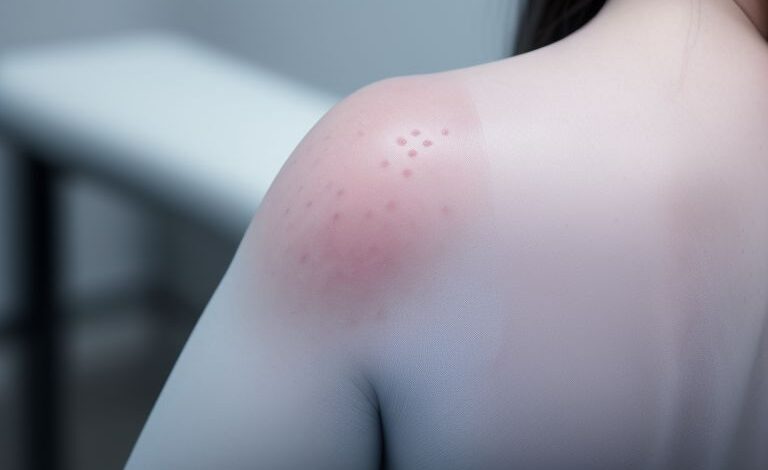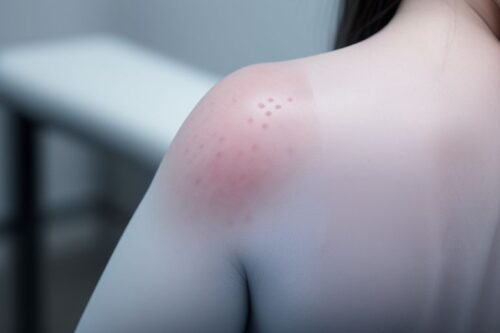
Lupus Rash on Arms: Symptoms, Causes, and Treatments
Lupus is a complex autoimmune disease that can manifest in various ways, with skin rashes being one of its most noticeable and distressing symptoms. Among these, the lupus rash on arms is quite common and often serves as an early sign of the disease. In this comprehensive guide, we will explore the different types of lupus rashes that can appear on the arms, their underlying causes, symptoms, and the best available treatments to manage them.
Understanding Lupus Rash on Arms
Lupus, or systemic lupus erythematosus (SLE), is a chronic autoimmune disorder in which the body’s immune system mistakenly attacks healthy tissues. This can lead to inflammation in various organs and tissues, including the skin. One of the hallmark features of lupus is the development of skin rashes, with the arms being a frequent location.

Why Do Lupus Rashes Develop on the Arms?
The skin is one of the most common organs affected by lupus. For many people with lupus, exposure to sunlight (ultraviolet light) is a major trigger. Since the arms are often exposed to the sun, they become a prime spot for lupus rashes. Ultraviolet (UV) light can exacerbate the immune response, leading to inflammation and skin lesions typical of lupus.
Other factors that contribute to lupus rashes include genetics, medications, environmental triggers, and hormonal changes. Each of these factors plays a role in triggering or worsening the rash.
Types of Lupus Rashes on Arms
There are several types of rashes associated with lupus that can appear on the arms. Each type has its own set of characteristics and patterns.
Acute Cutaneous Lupus Erythematosus (ACLE)
Acute cutaneous lupus erythematosus is often associated with a classic butterfly rash, which primarily affects the face but can also extend to the arms. The rash typically appears as red, raised, and sunburn-like patches that may be exacerbated by sun exposure. This type of lupus rash is usually a sign of systemic lupus, meaning that other parts of the body, like the kidneys and joints, may also be affected.
Symptoms of ACLE Rash on Arms:
- Red patches or lesions on the arms
- Raised and scaly appearance
- Sensitivity to sunlight
- Itching or discomfort
- Can worsen after sun exposure
Subacute Cutaneous Lupus Erythematosus (SCLE)
Subacute cutaneous lupus erythematosus is another form of lupus rash that often appears on sun-exposed areas of the skin, including the arms, shoulders, and chest. This type of rash is usually more widespread than ACLE and may appear as red, scaly rings or circular patches that do not scar but may leave pigmentation changes.
Symptoms of SCLE Rash on Arms:
- Circular or ring-shaped red patches
- Scaling and flaking skin
- Lesions that can spread across the arms and upper torso
- No scarring, but pigmentation changes
- Heightened sensitivity to UV light
Chronic Cutaneous Lupus Erythematosus (CCLE) or Discoid Lupus Erythematosus (DLE)
Discoid lupus erythematosus (DLE) is a more chronic form of lupus that typically affects the skin. DLE rashes are thick, disk-shaped lesions that often appear on the scalp, face, and arms. This type of rash can cause permanent scarring and hair loss if it appears on the scalp. On the arms, these lesions tend to be less severe but can still lead to discomfort and scarring.
Symptoms of DLE Rash on Arms:
- Thick, disk-shaped lesions
- Red and inflamed patches
- Scarring and possible skin discoloration
- Usually appears in a localized area
- Can cause long-term skin damage if left untreated
Lupus Panniculitis
Lupus panniculitis is a rare form of lupus that affects the deeper layers of the skin and fat tissue. This can lead to the development of firm nodules or lumps under the skin, commonly on the arms and thighs. These lumps can cause pain and lead to permanent indentations in the skin.
Symptoms of Lupus Panniculitis on Arms:
- Painful nodules or lumps beneath the skin
- Hardened areas of fat tissue
- Possible scarring or pitting of the skin
- Lesions may heal slowly and leave permanent marks
Bullous Lupus
Bullous lupus is another rare skin manifestation of lupus that can occur on the arms. It is characterized by the sudden appearance of blisters filled with fluid. These blisters can burst and leave behind raw, sensitive skin. Bullous lupus is often associated with more severe systemic lupus.
Symptoms of Bullous Lupus Rash on Arms:
- Fluid-filled blisters that appear suddenly
- Fragile, easily broken blisters
- Raw or open sores after blisters burst
- Risk of infection in open lesions
- Usually indicates more severe systemic lupus
Causes of Lupus Rash on Arms
The exact cause of lupus is not fully understood, but researchers believe that a combination of genetic, environmental, and hormonal factors contribute to the development of the disease. Here’s a closer look at the potential causes of lupus rashes on the arms.
Ultraviolet Light Exposure
UV light is one of the most well-known triggers for lupus rashes, particularly in sun-exposed areas like the arms. People with lupus often have photosensitivity, which means their skin reacts abnormally to sunlight. Even brief exposure to the sun can trigger an immune response, leading to inflammation and rash development.
Immune System Dysregulation
Lupus is an autoimmune disease, meaning the immune system mistakenly attacks healthy tissues, including the skin. In individuals with lupus, the immune system overreacts to environmental stimuli like sunlight, infections, or stress, resulting in inflammation and skin damage.
Genetic Factors
Genetics play a significant role in the development of lupus. If you have a family history of autoimmune diseases, you may be more susceptible to developing lupus. Certain genetic markers have been linked to an increased risk of developing lupus and its skin manifestations, including rashes on the arms.
Hormonal Triggers
Lupus is more common in women, particularly during childbearing years, which suggests that hormonal fluctuations may contribute to the disease. Estrogen, in particular, is thought to play a role in triggering lupus flare-ups and the development of lupus rashes.
Medications
Some medications, such as certain antibiotics, anti-seizure drugs, and blood pressure medications, can trigger a condition known as drug-induced lupus. In drug-induced lupus, patients may develop lupus-like symptoms, including skin rashes, which typically disappear after discontinuing the medication.
Diagnosing Lupus Rash on Arms
If you suspect that a rash on your arms might be related to lupus, it’s important to seek a proper diagnosis from a healthcare professional. Lupus is a complex condition that often requires a combination of clinical evaluations and diagnostic tests to confirm.
Physical Examination
A doctor or dermatologist will start by examining the rash and asking about your symptoms, including when the rash first appeared, whether it worsens with sun exposure, and if there are any accompanying symptoms such as joint pain or fatigue.
Blood Tests
Blood tests are commonly used to diagnose lupus and assess its severity. Some key blood tests include:
- Antinuclear Antibody (ANA) Test: A positive ANA test indicates that the body’s immune system is producing antibodies that can attack healthy tissues.
- Erythrocyte Sedimentation Rate (ESR): This test measures the level of inflammation in the body, which is often elevated in lupus patients.
- Complement Levels (C3, C4): Low levels of complement proteins may indicate active lupus inflammation.
Skin Biopsy
In some cases, a skin biopsy may be performed to confirm a lupus diagnosis. During a biopsy, a small sample of skin tissue is removed and examined under a microscope. This can help determine whether the rash is related to lupus or another skin condition.
Treating Lupus Rash on Arms
While there is no cure for lupus, there are several treatment options available to manage the symptoms and reduce the frequency of flare-ups. Treatment for lupus rashes focuses on reducing inflammation, preventing flare-ups, and minimizing discomfort.
Topical Corticosteroids
Topical corticosteroids are commonly prescribed to reduce inflammation and relieve itching associated with lupus rashes. These creams and ointments are applied directly to the rash and can help manage mild to moderate cases of lupus skin involvement.
How to Use:
- Apply a thin layer of corticosteroid cream to the affected areas of the arms once or twice daily as directed by your doctor.
- Avoid prolonged use, as overuse of corticosteroids can lead to skin thinning and other side effects.
Oral Medications
For more severe cases of lupus rashes, oral medications may be necessary. Some commonly prescribed oral medications for lupus include:
Antimalarial Drugs (Hydroxychloroquine)
Antimalarial drugs, such as hydroxychloroquine, are often used to treat skin rashes and other symptoms of lupus. These medications help reduce inflammation and prevent flare-ups. Hydroxychloroquine is usually taken daily and is considered a long-term treatment option.
Immunosuppressants
In cases where lupus rashes are severe or systemic lupus is present, immunosuppressants may be prescribed to control the immune system's overactivity. Drugs like azathioprine and mycophenolate mofetil are commonly used to suppress the immune system and reduce inflammation.
Sun Protection
Since UV exposure is a major trigger for lupus rashes, protecting your skin from the sun is essential. This can help prevent flare-ups and minimize the severity of rashes on the arms.
Sun Protection Tips:
- Wear sunscreen with a high SPF (30 or higher) every day, even on cloudy days.
- Cover your arms with protective clothing, such as long-sleeved shirts.
- Avoid direct sun exposure, especially during peak hours (10 a.m. to 4 p.m.).
- Seek shade whenever possible and consider wearing wide-brimmed hats to protect exposed areas.
Moisturizers and Soothing Creams
Keeping the skin on your arms moisturized can help soothe irritation and reduce the discomfort caused by lupus rashes. Look for gentle, fragrance-free moisturizers that are suitable for sensitive skin.
Recommended Ingredients:
- Aloe vera: Known for its soothing properties.
- Ceramides: Help to restore the skin’s natural barrier.
- Colloidal oatmeal: Reduces itching and inflammation.
Phototherapy
In some cases, phototherapy (light therapy) may be used to treat lupus rashes. Controlled exposure to ultraviolet light can help reduce inflammation and improve skin appearance. However, this treatment must be carefully monitored, as lupus patients are often sensitive to sunlight.
Alternative and Complementary Therapies
Some patients find relief from lupus rashes through alternative therapies. While these treatments should not replace conventional medical care, they can complement other treatment strategies.
Herbal Remedies
Certain herbs, such as turmeric and green tea, have anti-inflammatory properties that may help reduce lupus rash symptoms. Always consult with a healthcare provider before using herbal supplements, as they can interact with medications.
Diet and Nutrition
Eating an anti-inflammatory diet rich in fruits, vegetables, whole grains, and omega-3 fatty acids can support overall health and may help reduce lupus flare-ups. Foods high in antioxidants, such as berries and leafy greens, can help combat oxidative stress in the body.
Managing Lupus Rash Flare-Ups
Living with lupus means that flare-ups can occur unexpectedly, sometimes leading to a sudden worsening of rashes on the arms. Here are some practical strategies for managing flare-ups and minimizing their impact.
Stress Management
Stress is a well-known trigger for lupus flare-ups, including skin rashes. Finding ways to manage stress can help prevent or reduce the severity of flare-ups.
Stress-Reduction Techniques:
- Practice mindfulness or meditation.
- Engage in regular physical activity, such as yoga or walking.
- Ensure adequate sleep and rest.
- Talk to a therapist or counselor if stress becomes overwhelming.
Avoid Known Triggers
Identifying and avoiding known triggers is key to managing lupus rash flare-ups. In addition to sun exposure, triggers may include certain foods, medications, or environmental factors.
Follow Your Treatment Plan
Consistency is essential when managing lupus. Follow your doctor’s prescribed treatment plan and attend regular check-ups to monitor your condition and adjust your treatment as necessary.
Frequently Asked Questions
What does a lupus rash on the arms look like?
Lupus rashes on the arms often appear as red, raised patches or circular lesions. They can be scaly, itchy, and sensitive to sunlight. In severe cases, they may cause scarring or pigmentation changes.
Can lupus rashes on the arms be cured?
There is no cure for lupus, but lupus rashes can be managed with treatments such as topical corticosteroids, oral medications, and sun protection. Early intervention can help minimize the severity of the rash and reduce flare-ups.
Is it safe to go out in the sun if I have lupus?
If you have lupus, it’s important to limit sun exposure and use sun protection, such as sunscreen and protective clothing, to prevent flare-ups. UV light can worsen lupus rashes and cause other symptoms to flare up.
How long does a lupus rash on the arms last?
The duration of a lupus rash can vary depending on the severity of the flare-up and how quickly treatment is initiated. With proper treatment, rashes may clear up within a few weeks, but they can reoccur.
Can stress cause a lupus rash on my arms?
Yes, stress is a common trigger for lupus flare-ups, including rashes on the arms. Managing stress through relaxation techniques and lifestyle changes can help prevent flare-ups.
What foods should I avoid with lupus?
Foods high in saturated fats, processed sugars, and salt may contribute to inflammation and worsen lupus symptoms. It’s recommended to follow an anti-inflammatory diet rich in fruits, vegetables, and omega-3 fatty acids.
A lupus rash on the arms can be one of the earliest and most visible signs of lupus, but with proper diagnosis and treatment, it is manageable. Whether you're dealing with a mild rash or a more severe form of lupus skin involvement, understanding the symptoms, triggers, and treatments can help you take control of your condition. Remember to consult with your healthcare provider to develop a personalized treatment plan, protect your skin from the sun, and adopt healthy lifestyle changes to manage lupus and its skin manifestations effectively.

